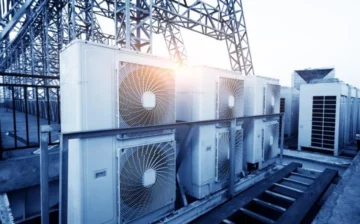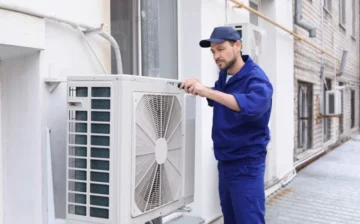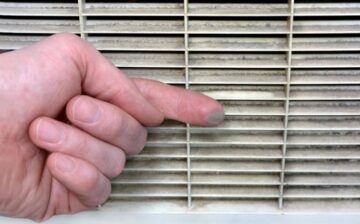During the summer months, keeping your air conditioner running smoothly is essential. Proper DIY maintenance of your AC unit is essential to ensuring that you and your family stay cool and comfortable all season long. Furthermore, regular maintenance can help you save money on costly repairs.
Only some people have the knowledge or know-how to properly maintain an air conditioner, but with this guide, you can keep your AC functioning efficiently and effectively. Read on for tips on how to DIY your home air conditioner maintenance.
Cleaning or replacing the air filter
One of the most straightforward and crucial DIY maintenance tips for keeping your AC running optimally is to clean or replace the air filter regularly. A clogged or dirty filter restricts airflow and reduces system efficiency, leading to higher energy bills and potential damage to the system itself. You should check the filter every 30 to 90 days and replace it if needed.
Furthermore, to ensure the air quality in your home is healthy, you should clean or replace the filter at least twice a year, once at the beginning of summer and again at the end. You can replace the filter by following these steps:
Step 1: Turn off the AC system at the thermostat and switch off all power to the unit.
Step 2: Open up your air conditioning unit’s service panel and locate the filter.
Step 3: Carefully remove it, noting which way it is installed so that you can replace it correctly later on.
Step 4: Throw away the old filter and replace it with a new one, ensuring you insert it in the same direction.
Step 5: Close up the service panel and restore power to the unit at the thermostat.
Cleaning the coils and fins
Another critical step in DIY air conditioner maintenance is to clean the outdoor condenser unit’s coils and fins. The condenser unit collects dust, dirt, leaves, and other debris over time, leading to airflow blockages.
To clean the coils and fins, you’ll need to:
Step 1: Switch off the power to the AC at the circuit breaker box.
Step 2: Carefully remove any dirt from around the exterior unit using a soft brush or vacuum cleaner with a soft brush attachment.
Step 3: Remove any leaves collected in your condenser unit using tweezers or a vacuum cleaner with a soft brush attachment.
Step 4: Spray the unit with a low-pressure garden hose to remove dirt and debris.
Step 5: Let the unit dry for 10 minutes before switching the power back to the circuit breaker box.
Make sure all hoses and tubing are in good condition
The hoses and tubing connecting to your AC unit should also be checked regularly for any sign of damage. If you notice any cracked or broken hoses, they should be replaced immediately. Damaged hoses can cause water leaks and air blockages resulting in reduced efficiency and higher energy bills.
Moreover, regularly checking the insulation covering the tubing and hoses is essential. Over time, the insulation can wear away or damage due to weather conditions, pests, or other factors. If this is the case, replace the insulation immediately to prevent costly repairs in the future.
It’s also essential to clean the condensate drain line every few months. This will help remove clogs or blockages that may prevent the system from draining correctly. To do this, you can use a wet/dry vacuum cleaner with an extension hose attachment to suck out any accumulated dirt and debris in the drain line. Always remember never to ignore signs that you need to replace your AC unit.
Check the thermostat settings
Finally, ensuring your thermostat is set to the correct settings can help ensure your air conditioner runs efficiently. The ideal temperature setting should be around 78°F (25°C) in summer and 68°F (20°C) in winter. You should also ensure that you use the correct type of thermostat for your AC system, as this will affect how efficiently it runs.
The thermostat should also be checked regularly to ensure all settings work correctly. If your AC is not responding to the thermostat, it could be a sign of an incorrect setting or a malfunctioning part that needs replacing.
A programmable thermostat can help keep your AC running efficiently all summer by automatically adjusting the temperature settings when you are away from home or asleep.
All in all
By correctly maintaining your air conditioning unit and taking the necessary steps to keep it running efficiently, you can ensure that your AC is ready for the summer months. In addition to regular DIY maintenance, you should also have a professional HVAC technician inspect and service your unit annually before the heat peaks.
Ultimately, DIY air conditioner maintenance is a simple and cost-effective way to keep your AC running smoothly all summer. With the help of these tips, you can ensure that your system is optimized for peak performance and efficiency. As a result, you can save money on energy bills and enjoy the cool comfort of your air conditioner.
We hope you found this blog post on DIY air conditioner maintenance tips: Keep your AC running smoothly all summer long useful. Be sure to check out our post on AC Maintenance Tips to Help Unit Running Smoothly for more great tips!
Have Experience in the Moving Industry? Want an Additional Income Stream? Work With All Around Moving!
Partner with All Around Moving and join the Work With Us program. We’ll help you make money arranging moving services, by establishing your own moving consultant business operation. Read the simple terms by Clicking here to learn more.






